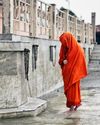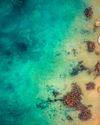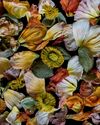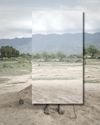
These autodidact architects planned, designed, and constructed homes characterized by their personal tastes and preferences with driftwood and discarded construction materials. Over time these homes are abandoned or destroyed by nature or the human hand. The remnants are recycled regularly as material wealth is scarce here at the sea-salt-flats village.
In the harshest of environments, our planet harbors human beings, disregarded carpets once serving soft feet, consumer-waste advertisements, tarpaulins with famous brands, and plastics of any kind function as isolation.
Though salt plays a crucial role in maintaining human health and the landscapes are captivating to the eye, harvesting it from the sea is a harsh job. First, in wooden trays, the sun evaporates the water. Then, the wet slabs of salt are collected and left to dry further in neatly crafted heaps on shore. Broken up, it is shoveled into a mound that will slowly turn into hard rock. Finally, this mound is smashed to pieces again and scooped into bags for transportation.
The laborers here work from sunrise to sunset and are always in touch with the salty waters of the Red Sea. Many are from Sudan and send the meager money earned back home. This financial support can be quite extended, covering elderly parents, brothers, and sisters, even sending offspring to further their education, securing a better future for generations to come. Every alternate year, the workers are allowed to visit their families for an extended period, and at the end of their contract, they return home with one month of salary for every year worked.
This story is from the October 2022 edition of Lens Magazine.
Start your 7-day Magzter GOLD free trial to access thousands of curated premium stories, and 9,000+ magazines and newspapers.
Already a subscriber ? Sign In
This story is from the October 2022 edition of Lens Magazine.
Start your 7-day Magzter GOLD free trial to access thousands of curated premium stories, and 9,000+ magazines and newspapers.
Already a subscriber? Sign In

IN THE SHIPYARDS OF DHAKA
A very large shipyard in Dhaka is located on the Buriganga River's banks, directly across Dhaka's old city.

Aga Szydlik INDIA
A JOURNEY INTO THE LAND OF DIVERSITY, CULTURE, AND COLORS

SEBASTIAN PIÓREK EXPLORING Enjoyable LANDSCAPE
I retrieved the idea of nature closely linked to the field of human feelings.

The Extreme Macro Photography of Bees
AN INTERVIEW SAM WITH, DROEGE

JEAN KAROTKIN GYMNOPEDIES
Gymnopédies, Karotkin's ongoing series of botanical portraits, takes its name from a trio of piano compositions by 19th-century French composer Erik Satie.

BUTTERFLIES IN LOVE WITH FLOWERS
I sometimes think Chinese art is not fully appreciated in the West. I was exposed to it growing up in Australia, although my fascination was more with calligraphy.

Lissa Hahn:
Hahn: HOW TO EVOKE A PAVLOVIAN RESPONSE IN HUMANS

AN EXCLUSIVE INTERVIEW WITH ELENA PARASKEVA
Elena Paraskeva is an internationally acclaimed, award-winning Conceptual Photographer and Art Director and, most recently, an official ADOBE instructor.

From a Living Hell to Heaven on Earth: the Inhumanity and Humanity of Humans
In a remote area of western Wisconsin, dogs and cats who otherwise would have ended up on death row are given a reprieve. They can now live out their lives in peace and comfort and with companionship at Home for Life (HFL), which was not afforded them outside the sanctuary's gates.

The Art of DISAPPEARING
In the classical proposal, indigenous people are usually the topic of discussion, but rarely do they have a hand in shaping it.